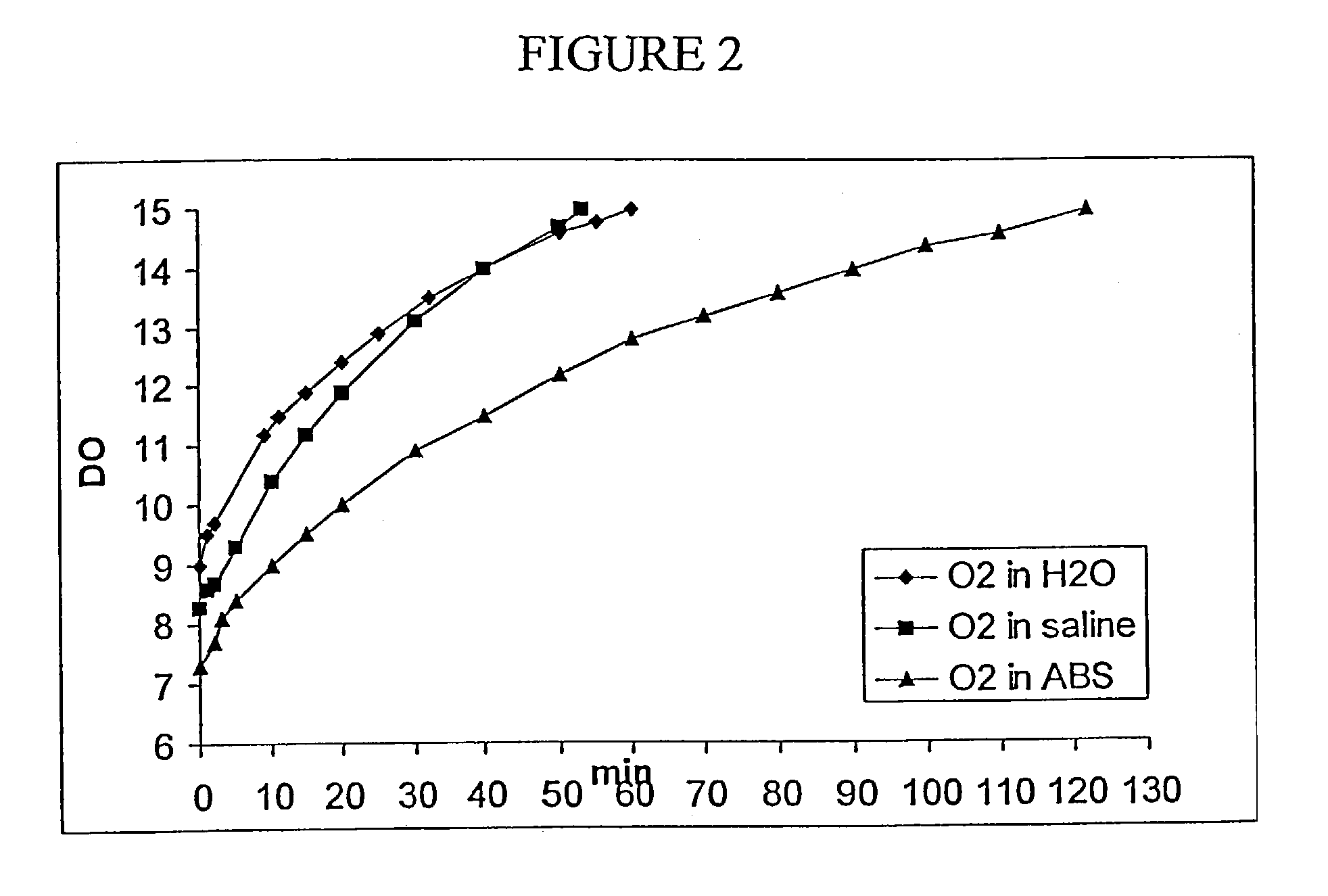Matrix for oxygen delivery to compromised tissues
a tissue and matrix technology, applied in the field of tissues for oxygen delivery to compromised tissues, can solve the problems of collagen wound dressings that cannot readily conform to varied wound shapes, collagen film and sponges do not readily conform to the various types of compromised tissues, and collagen wound dressings have poor fluid absorption properties, etc., to achieve the effect of easy manufacturing, easy replacement of compromised tissues, and easy conformation to the shape of compromised tissue sites
- Summary
- Abstract
- Description
- Claims
- Application Information
AI Technical Summary
Benefits of technology
Problems solved by technology
Method used
Image
Examples
example 1
Preparation of Oxygen-Containing Closed Cell Foam Device
[0125]The following experiment was conducted to make an oxygen containing closed cell foam device out of polyacrylamide matrix. More specifically the experiment involved use of hydrogen peroxide catalyzed by iodide in polyacrylamide matrix to form oxygen foam.
[0126]ACRYDERM® matrix material is a unique matrix that is water absorbent, elastic, and oxygen permeable (see U.S. Pat. No. 5,928,174). In order to elevate oxygen levels in the matrix for use as an oxygen donator, some treatment must be done post-polymerization, as oxygen quenches the polymerization of polyacrylamide. As demonstrated below, this was accomplished by allowing hydrogen peroxide to be absorbed into the matrix, where it contacted a decomposition catalyst and formed oxygen cavities.
Experimental Design:
[0127]1) A batch of ACRYDERM® matrix material was made incorporating 1% sodium iodide pre-polymerization. To 42.5 g H2O add 2.47 g acrylamide, 0.03 g bis acrylami...
example 2
Comparison of Matrices Formulated with Alternative Peroxide Catalysts
[0136]The following experiment was conducted to make closed cell foam devices using hydrogen peroxide and alternative catalysts to sodium iodide.
[0137]It has been demonstrated that a closed cell foam incorporating oxygen bubbles can be made using iodide as a hydrogen peroxide decomposition catalyst. However, the catalytic reaction results in iodine gas formation, which does not dissipate quickly and leaves an odor. Also, residual sodium iodide in the device is not desired. Therefore, a decomposition catalyst that left either harmless residuals or no residuals was desirable.
Experimental Design
[0138]1) 3 control ACRYDERM® matrices were used.[0139]2) Each was treated as follows: Soak 1 in a solution of cupric chloride to bring the final concentration to 2%. Soak 1 in a solution of ferric sulfate to bring the final concentration to 2%. Soak 1 in a sodium carbonate solution.[0140]3) Soak each matrix in excess 3% hydroge...
example 3
Rate of Release of Oxygen from Matrices into Water Substrate
[0151]The following experiment was conducted in order to test the rate of release of oxygen from foamed devices into water using a membrane dissolved oxygen electrode and meter.
[0152]As discussed above, topical application of oxygen to compromised tissue benefits healing. Theoretically, oxygen in the foamed matrix dissolves in the membrane moisture or exudate and enters the compromised tissue as dissolved oxygen. An in vitro simulation of this type of environment may be manufactured using water sealed in a bottle to prevent the escape or ingress of gases.
Experimental Design
The following steps were followed:
[0153]1) Place 0.7 mL 10% hydrogen peroxide on 0.6 g of a previously made matrix that incorporates 1% sodium carbonate.[0154]2) 24 hrs later, place some of the foamed matrix in 110 mL distilled water in a sealed glass bottle excluding any air bubbles.[0155]3) A dissolved oxygen probe was inserted in the bottle with a stir...
PUM
| Property | Measurement | Unit |
|---|---|---|
| survival time | aaaaa | aaaaa |
| time | aaaaa | aaaaa |
| biocompatible | aaaaa | aaaaa |
Abstract
Description
Claims
Application Information
 Login to View More
Login to View More - R&D
- Intellectual Property
- Life Sciences
- Materials
- Tech Scout
- Unparalleled Data Quality
- Higher Quality Content
- 60% Fewer Hallucinations
Browse by: Latest US Patents, China's latest patents, Technical Efficacy Thesaurus, Application Domain, Technology Topic, Popular Technical Reports.
© 2025 PatSnap. All rights reserved.Legal|Privacy policy|Modern Slavery Act Transparency Statement|Sitemap|About US| Contact US: help@patsnap.com



